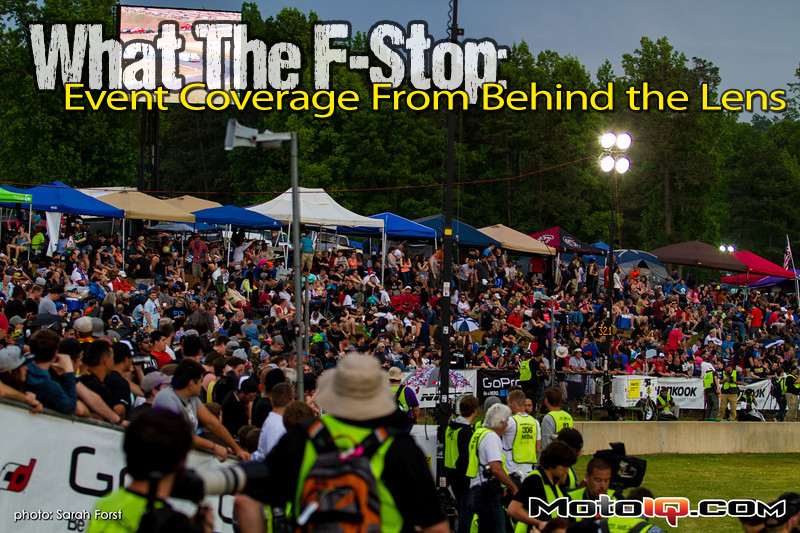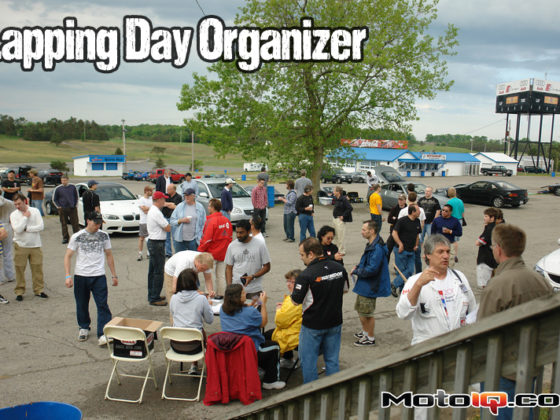,
Racing is dangerous. When drivers strap in to their seats, they inherently know the risks of going all out on the track. As photographers, we sometimes feel a little invincible behind the camera. There’s a false sense of security you have witnessing everything unfold through the lens as if watching it on TV. It can be quite eye-opening to finally put the camera down and come face to face with reality.
 Fade to black. “Hey dude, you realize there are crashing cars in front of you, right?”
Fade to black. “Hey dude, you realize there are crashing cars in front of you, right?” “Ummm… you guys see a lens cap anywhere? Can I borrow some kitty litter for my pants?”
“Ummm… you guys see a lens cap anywhere? Can I borrow some kitty litter for my pants?” Compete annihilation right in front of the photogs.
Compete annihilation right in front of the photogs.  Photog instinct says keep shooting. Human instinct says duck or run for your life. That front wheel has its target locked on the camera strapped to the guardrail.
Photog instinct says keep shooting. Human instinct says duck or run for your life. That front wheel has its target locked on the camera strapped to the guardrail. Flying shrapnel is a hazard- keep your eyes peeled for shooting brake rotors.
Flying shrapnel is a hazard- keep your eyes peeled for shooting brake rotors.I was shooting FD at Wall Speedway a few years ago when Tyler McQuarrie and Chelsea Denofa raced doggie style. The guardrail between their cars and the media pit was prone to flipping a car that humped it a little too hard. I only put the camera down once I realized I was only getting pictures of stickers on the rear quarter panel, just in time to back up for the advancing debris wave.
 This is one of the last pics I could grab before the telephoto lens became useless due to how close the crash was.
This is one of the last pics I could grab before the telephoto lens became useless due to how close the crash was.  It wasn't until the next day as I watched one of the million goPro videos did I realize how close McQuarrie was from flipping up over the guardrail and overtaking a few speed bumps with cameras.
It wasn't until the next day as I watched one of the million goPro videos did I realize how close McQuarrie was from flipping up over the guardrail and overtaking a few speed bumps with cameras. After the Denofa/McQuarrie crash, media was prohibited from shooting at that corner for safety reasons. Only FD staff is allowed to get the money shot now.
After the Denofa/McQuarrie crash, media was prohibited from shooting at that corner for safety reasons. Only FD staff is allowed to get the money shot now.A few tips on getting that car racing photo with your DSLR:
– Use the correct shutter speed. Show motion in car racing with a slower shutter speed like speed of 1/125 but if you want laser sharp, go for 1/500 or 1/1000. These speeds will make the object appear motionless but will have excellent focus. A shutter speed of 30 seconds (on a tripod) can provide a long enough exposure to blur moving objects like people walking around but will create a sharp photo of reflections or if shooting roads, will blur the lines of the head and tail lights but focus on the landscape.
– Panning will display motion with a blurred background but focus on the car. Follow the car in a smooth motion while pressing the shutter button.
– Location, location, location. Find a dramatic corner for the action and try to cover different areas of the track.
– Think about composition, which is basically the relationship of objects within the photo. There should be a clear focal point the person viewing the photo can identify.
– Fill the frame. Don't place the focus object in the center of every frame in order to illustrate the grade of a sweeper or road surface. Contrasting color or light provides more depth to the action being captured. Don't let the background compete with the area you want to focus on.
– Horizontal lines produce static pictures while diagonal lines (a shift in position) create a dynamic feeling and add excitement and movement. This can be accomplished by taking a photo of a car up from a kneeling or ground position or a car passing by on an angle rather than straight on.
– Bright primary colors against a monochromatic background or complimentary tone produce vibrant contrasts and striking photos. Some racing teams are very clever about their paint schemes with red and yellow, or dark blue and fluorescent green paint and stickers. A car that photographs well will inherently get more media coverage.
It's hard work but somebody's got to do it! If we bitch a little about bug bites, sunburns, lack of sleep, and hungry bellies, just ignore our whining. I sure wouldn't trade this for anything!
 Photo for sale AKA “the money shot.”
Photo for sale AKA “the money shot.”


